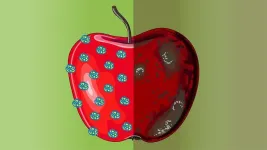(Press-News.org) Abigail Lewis traveled all across the United States for college and graduate school, and she ended up researching lakes in her own hometown.
For one of her graduate research projects, Lewis analyzed 656 lakes across five continents with an international research team. The lakes in her hometown of Waukesha, Wisconsin, were among those included.
“To look back and pull together these two parts of my life has been really satisfying,” said Lewis, who will earn her Ph.D. in biological sciences this spring.
In a paper recently published in Global Change Biology, Lewis and her team provide empirical evidence supporting a theory that low deep-water oxygen concentrations in a given year perpetuate a continued cycle of low oxygen, also known as anoxia, in following years. This is known as a positive feedback.
Of the total lakes studied, 356 had 10 years of data, and from these the team found 34 percent crossed the threshold of going from oxic, or with oxygen, to anoxic. Only 90 lakes of these 356 analyzed never experienced a year of anoxia.
This diagram shows the positive feedback cycle where low oxygen concentrations in the deep waters perpetuates a continued cycle of low oxygen. Image courtesy of Abigail Lewis.
“We document a positive feedback where low oxygen conditions in the bottom waters of lakes around the world lead to increased algal growth and the decomposition of algae further promotes oxygen declines,” said Lewis, who is also an Interfaces of Global Change Fellow.
Algae blooms affect the water quality and disrupt the ecosystems of lakes. They can be toxic to humans, lead to the release of metals such as arsenic, and lead to massive fish kills. Deep-water anoxia leads to the release of phosphorus from sediments, which exchanges with the well-lit surface waters and contributes to algae blooms.
“It’s especially important to prioritize conservation efforts for lakes that are approaching the threshold of experiencing anoxia but are not quite there yet,” Lewis said. “Any efforts that are dedicated to stopping the problem from happening in the first place are worth substantially more than efforts to try and restore a lake after problems have already happened. Once you start having frequent algal blooms, it’s almost too late.”
Two factors can influence whether a lake becomes anoxic: climate change and land use.
“Climate change on a long-term time scale is within our control, on a short-term time scale it’s not. The land-use decisions that we make are potentially really important because that’s something that we can control on a short-term time scale,” Lewis said.
While interventions were not a part of this study, researchers have long known that low oxygen conditions can cause water quality problems, so they already have a stash of interventions to prevent lakes from becoming anoxic. However, Lewis and her team’s empirical evidence for a positive feedback effect will help researchers and water managers gain support from the public.
Lewis' dip into this lake of research began during her first semester of graduate school in 2019, when she attended an international conference on lake ecology and participated in a working group session. She and her team are members of the Global Lake Ecological Observatory Network (GLEON).
“GLEON is an amazing group of lake scientists from all around the world, and they have a supportive culture where they encourage early career scientists to step up and take the lead on projects,” Lewis said.
Lewis’s advisor is Cayelan Carey, professor of biological sciences in the College of Science as well as a Global Change Center and Fralin Life Sciences Institute affiliated faculty.
Going forward, Lewis is pleased that the data gathered from the research will be disseminated internationally.
“We have 22 authors from around the world, so this information is going to go out globally to help spread the word,” Lewis said. “That’s optimistic.”
END
Low oxygen in lakes may breathe new life into conservation efforts for water quality
2024-02-21
ELSE PRESS RELEASES FROM THIS DATE:
Engineering a coating for disease-free produce
2024-02-21
Dr. Mustafa Akbulut, professor of chemical engineering, has teamed up with horticultural science professor Luis Cisneros-Zevallos to engineer longer-lasting, bacteria-free produce.
According to Akbulut’s recent publication in Current Research in Food Science, the global fruit and vegetable market loses over 50% of agricultural fruit production during various stages of produce handling and post-harvest treatments.
Many fruits and vegetables already have a layer of food-grade wax that is applied for cosmetic reasons and to prevent water loss. Akbulut’s research combines such wax with nano-encapsulated cinnamon-bark ...
Ochsner Children’s Hospital advocates to close the gap in pediatric heart care
2024-02-21
NEW ORLEANS, LA - Ochsner Children's Hospital, ranked among the top hospitals in the nation for pediatric cardiology and congenital heart surgery, is raising awareness of the need for more pediatric-specific heart devices. As the only pediatric heart transplant program in Louisiana and the only program in the state to offer advanced mechanical support options for pediatric cardiology patients, Ochsner Children’s Hospital is committed to advocating for additional medical devices to enhance its high-quality care to pediatric patients ...
Cobalt-free electrodes achieved with nickel ions
2024-02-20
Many electric vehicles are powered by lithium-ion batteries that rely on cobalt — a scarce, expensive metal with high environmental and social costs. A team of researchers from Japanese and French universities have now developed a practical nickel-based electrode material that opens new avenues to cobalt-free batteries for electric vehicles.
The researchers detailed their findings in a study published on Jan. 15 in the journal Energy Storage Materials.
“There is an undeniable need for cobalt-free, high-energy electrode materials for lithium-ion ...
Throwing lithography a curve
2024-02-20
At the heart of advancing semiconductor chip technology lies a critical challenge: creating smaller, more efficient electronic components. This challenge is particularly evident in the field of lithography, the process used to create intricate patterns on semiconductor materials (called wafers) for the production of chips. Lithography uses a kind of template, called a photomask — or just mask — for creating patterns on semiconductor wafers. The industry is always looking for methods that improve resolution and manufacturability for both masks and ...
St. Jude taps health care start-up veteran as first Senior Vice President of Tech Commercialization
2024-02-20
(MEMPHIS, Tenn., February 20, 2024) St. Jude Children’s Research Hospital has appointed Lisa Jordan, MS, MBA, as the institution’s first-ever Senior Vice President of Technology Commercialization to lead industry partnerships and the commercialization of innovations. Jordan will work with researchers to bring a greater number of new technologies, innovations and scientific breakthroughs to the clinic, enabling breakthroughs from St. Jude laboratories to benefit more patients.
The move, part of the institution’s 2022-2027 ...
Microplastics in every human placenta, new UNM Health Sciences research discovers
2024-02-20
A flurry of recent studies has found that microplastics are present in virtually everything we consume, from bottled water to meat and plant-based food. Now, University of New Mexico Health Sciences researchers have used a new analytical tool to measure the microplastics present in human placentas.
In a study published February 17 in the journal Toxicological Sciences, a team led by Matthew Campen, PhD, Regents’ Professor in the UNM Department of Pharmaceutical Sciences, reported finding microplastics in all 62 of the placenta samples tested, with concentrations ranging from 6.5 to 790 micrograms ...
Examining a century of change in a New York City urban forest
2024-02-20
There haven’t been many long-term studies on urban forests, but data collected from the Thain Family Forest, which the New York Botanical Garden (NYBG) has been stewarding for more than a century, has provided an opportunity for scientists from The Forest School at YSE to study a century of changes of its composition.
Using inventory data from 1937-2021, Eliot Nagele ’21 MF, who initiated the research while a forester at Thain and a student at YSE, documented changes in forest structure, diversity, and composition to assess the health of the forest over time. ...
Salk scientists discover new target for reversible, non-hormonal male birth control
2024-02-20
LA JOLLA (February 20, 2024)—Surveys show most men in the United States are interested in using male contraceptives, yet their options remain limited to unreliable condoms or invasive vasectomies. Recent attempts to develop drugs that block sperm production, maturation, or fertilization have had limited success, providing incomplete protection or severe side effects. New approaches to male contraception are needed, but because sperm development is so complex, researchers have struggled to identify parts of the process that can be safely and effectively tinkered ...
Unlike men, for professional women, having high-status connections can backfire
2024-02-20
Women working in organizations are frequently encouraged to cultivate connections to high-status individuals based on a prominent social network theory. But new research conducted in China and the United States suggests that having high-status connections can backfire for women.
The study, by researchers at Carnegie Mellon University and the University of Michigan, appears in Organizational Science.
“Our findings reveal a social-network dilemma for women that is contrary to a widely accepted belief that women should build their network with high-status individuals,” said Catherine Shea, Assistant Professor of Organizational Behavior and Theory at Carnegie Mellon's Tepper School ...
Time watching videos may stunt toddler language development, but it depends on why they're watching
2024-02-20
DALLAS (SMU) – A new study from SMU psychologist Sarah Kucker and colleagues reveals that passive video use among toddlers can negatively affect language development, but their caregiver’s motivations for exposing them to digital media could also lessen the impact.
Results show that children between the ages of 17 and 30 months spend an average of nearly two hours per day watching videos – a 100 percent increase from prior estimates gathered before the COVID pandemic. The research reveals a negative association between high levels of digital media watching and children’s vocabulary development.
Children exposed to videos ...







